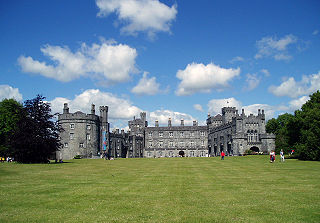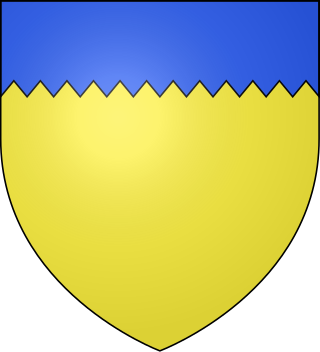Related Research Articles

Kilkenny Castle is a castle in Kilkenny, Ireland, built in 1260 to control a fording-point of the River Nore and the junction of several routeways. It was a symbol of Norman occupation, and in its original 13th-century condition, it would have formed an important element of the town's defences with four large circular corner towers and a massive ditch, part of which can still be seen today on the Parade.
Events from the year 1955 in Ireland.

Callan is a town and civil parish in County Kilkenny in Ireland. Situated 16 km (10 mi) south of Kilkenny on the N76 road to Clonmel, it is near the border with County Tipperary. It is the second largest town in the county, and had a population of 2,475 at the 2016 census. Callan is the chief town of the barony of the same name.

Gowran is a town located on the eastern side of County Kilkenny, Ireland. The historic St. Mary's Collegiate Church is located in the centre of Gowran close to Gowran Castle. Gowran Park race course and Golf Course are located one km from the centre of Gowran. Gowran is located on the R448 regional road where it is crossed by the R702 regional road. The town is in a townland and civil parish and barony of the same name.

James Stephens was an Irish Republican, and the founding member of an originally unnamed revolutionary organisation in Dublin. This organisation, founded on 17 March 1858, was later to become known as the Irish Republican Brotherhood (I.R.B).

Tynan is a village, townland and civil parish in County Armagh, Northern Ireland. It is situated largely in the historic barony of Tiranny, with some areas in the barony of Armagh, around 11 kilometres (7 mi) west of Armagh City.
Butler is a surname that has been associated with many different places and people. It can be either:

James Wandesford Butler, 1st Marquess of Ormonde, was an Irish nobleman and politician. He was the second son of John Butler, 17th Earl of Ormonde and Frances Susan Elizabeth Wandesford. He was born at Kilkenny castle on 15 July 1774.
John Butler, 17th Earl of Ormonde, 10th Earl of Ossory (1740–1795) was an Irish peer and Member of Parliament (MP). He became a Protestant in 1764. He was an Irish MP, representing Gowran between 1776 and 1783, and Kilkenny City between 1783 and 1792. In 1791, his right to the peerage was acknowledged in the Irish House of Lords and he became the 17th Earl of Ormond.

St Kieran's College is a Roman Catholic secondary school, located on College Road, Kilkenny, County Kilkenny, Ireland.
Events from the year 1830 in Ireland.
Events from the year 1822 in Ireland.
Events from the year 1858 in Ireland.
Events from the year 1825 in Ireland.
The Mayor of Kilkenny is an honorific title used by the head of Kilkenny Borough Council. The Council has jurisdiction throughout its administrative area which is the city of Kilkenny in the Republic of Ireland. The office was established in the 16th century and had significant powers. The office was all but abolished under the Local Government Act 2001. All that remains of the office, per section 11 of the Act is a symbolic role: "Subject to this Act, royal charters and letters patent relating to local authorities shall continue to apply for ceremonial and related purposes in accordance with local civic tradition but shall otherwise cease to have effect.". The Act goes on to state the chairman of the Council must be styled the Cathaoirleach and that "Any reference in any other enactment to the lord mayor, mayor, chairman, deputy lord mayor, deputy mayor or vice-chairman or cognate words shall, where the context so requires, be read as a reference to the Cathaoirleach or Leas-Chathaoirleach or other title standing for the time being.".

Butler is the name of a noble family whose members were, for several centuries, prominent in the administration of the Lordship of Ireland and the Kingdom of Ireland. They rose to their highest prominence as Dukes of Ormonde. The family has produced multiple titles such as Baron Cahir, Baron Dunboyne, Viscount Ikerrin, Viscount Galmoye, Viscount Mountgarret, Viscount Thurles, Earl of Carrick, Earl of Kilkenny, Earl of Ormond, Earl of Ossory, Marquess of Ormonde and Duke of Ormonde. Variant spellings of the name include le Boteler and le Botiller. The Butlers were descendants of Anglo-Norman lords who participated in the Norman invasion of Ireland in the 12th century. The surname has its origins in the hereditary office of "Butler (cup-bearer) of Ireland", originating with Theobald Walter, 1st Chief Butler of Ireland. The arms of later family members depicted three cups in recognition of their original office.
The High Sheriff of County Kilkenny was the British Crown's judicial representative in County Kilkenny, Ireland from the 16th century until 1922, when the office was abolished in the new Free State and replaced by the office of Kilkenny County Sheriff. The sheriff had judicial, electoral, ceremonial and administrative functions and executed High Court Writs. In 1908, an Order in Council made the Lord-Lieutenant the Sovereign's prime representative in a county and reduced the High Sheriff's precedence. However, the sheriff retained his responsibilities for the preservation of law and order in the county. The usual procedure for appointing the sheriff from 1660 onwards was that three persons were nominated at the beginning of each year from the county and the Lord Lieutenant then appointed his choice as High Sheriff for the remainder of the year. Often the other nominees were appointed as under-sheriffs. Sometimes a sheriff did not fulfil his entire term through death or other event and another sheriff was then appointed for the remainder of the year. The dates given hereunder are the dates of appointment. All addresses are in County Kilkenny unless stated otherwise.

James Perry was an Irish luthier from Dublin, known for making violins, violas and cellos. His workshop was based in Kilkenny and also produced instruments such as guitars, German flutes, fifes and tenors. Perry is credited with having made over 1000 instruments. He was a brother and apprentice of Dublin luthier, Thomas Perry, and a protégé of the Ormonde family of Kilkenny Castle.
Achmet Borumborad, or Achmet Borumbadad, was the assumed name of an eccentric medical con-artist, or quack, operating in late 18th-century Dublin, who succeeded in gathering financial support for the construction of a Turkish bath on the banks of the River Liffey. Purportedly a doctor, he claimed to have been born in Constantinople (Istanbul) from which he had subsequently fled. In reality, he was the fictitious creation of Patrick Joyce of Kilkenny, or possibly William Cairns of Dublin. Adopting the persona of a native Turk, his unusual dress style, turban, and exotic affectations attracted much attention in the city at the time, and he was noted as "the first Turk who had ever walked the streets of Dublin in his native costume."
References
- ↑ From County Cork, became editor of the Kilkenny Moderator.
- ↑ O'Riordan, Turlough (2009). "Borumborad, Achmet (Joyce, Patrick)". Dictionary of Irish Biography . Royal Irish Academy. doi:10.3318/dib.004363.v1.
- ↑ Fallon, Donal (1 March 2018). "The curious story of Achmet Borumborad and the Turkish Baths". comeheretome.com. Retrieved 6 November 2022.
- ↑ Siggins, Lorna (20 November 1996). "The Liffey in Dublin". The Irish Times . Retrieved 6 November 2022.
- ↑ "Chapter XIX. Dr. Achmet Borumborad". www.chaptersofdublin.ie. Retrieved 6 November 2022.
- ↑ "HistoricPlaces.ca - HistoricPlaces.ca".